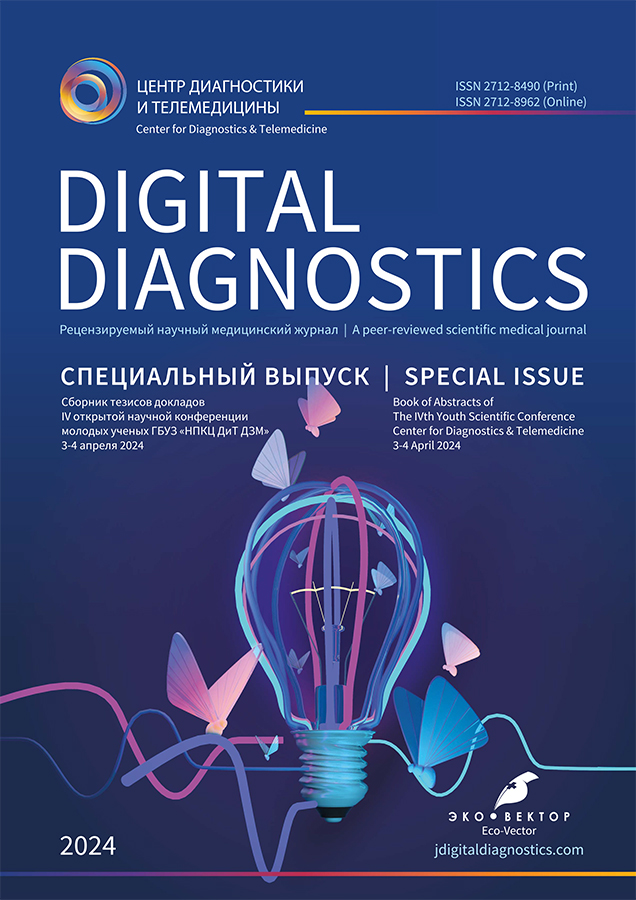Using neural networks for non-invasive determination of glycated hemoglobin levels, illustrated by the application of an innovative portable glucometer in clinical practice
- Авторлар: Poliker E.E.1, Koshechkin K.A.1, Timokhin A.M.1, Klyukina E.V.1, Belyakova E.D.2, Brovko A.M.3, Lalayan A.S.4, Ermolaeva A.S.1
-
Мекемелер:
- The First Sechenov Moscow State Medical University
- Research and Practical Clinical Center for Diagnostics and Telemedicine Technologies
- Moscow Institute of Physics and Technology
- Lomonosov Moscow State University
- Шығарылым: Том 5, № 1S (2024)
- Беттер: 124-126
- Бөлім: Articles by YOUNG SCIENTISTS
- ##submission.dateSubmitted##: 17.02.2024
- ##submission.dateAccepted##: 27.03.2024
- ##submission.datePublished##: 03.07.2024
- URL: https://jdigitaldiagnostics.com/DD/article/view/627099
- DOI: https://doi.org/10.17816/DD627099
- ID: 627099
Дәйексөз келтіру
Толық мәтін
Аннотация
BACKGROUND: In the last decade, there has been a significant increase in interest in non-invasive monitoring of blood glucose levels [1]. This is driven by the desire to reduce patient discomfort, as well as the risk of infections associated with traditional invasive methods [2]. Raman spectroscopy, considered as a promising approach for non-invasive measurements [3], combined with machine learning, has the potential to lead to more accurate and faster diagnostic methods for conditions related to glucose imbalances [4].
AIMS: Development and validation of a new portable glucometer based on Raman spectroscopy using machine learning methods for non-invasive determination of glycated hemoglobin (HbA1c) levels.
MATERIALS AND METHODS: The study was conducted on a sample of 100 volunteers of different age groups and genders, with varying health statuses, including individuals with type 1 and type 2 diabetes and those without diabetes. To collect data, we used a portable device developed by us, based on the registration of Raman spectra with laser excitation at 638 nm. The data were analyzed using Support Vector Machine neural networks.
RESULTS: After processing the spectroscopic measurements using Support Vector Machine, the system showed sensitivity (95,7%) and specificity (84,2%) in determining HbA1c levels comparable to traditional methods such as high-performance liquid chromatography. It was found that the algorithm is sufficiently adaptive and can be used across a wide range of skin types, regardless of the age and gender of the participants. The results suggest the possibility of using the developed device in clinical practice.
CONCLUSION: The developed portable glucometer based on Raman spectroscopy combined with machine learning algorithms could be a promising step towards non-invasive and continuous monitoring of glycemic levels in patients with diabetes.
Толық мәтін
BACKGROUND: In the last decade, there has been a significant increase in interest in non-invasive monitoring of blood glucose levels [1]. This is driven by the desire to reduce patient discomfort, as well as the risk of infections associated with traditional invasive methods [2]. Raman spectroscopy, considered as a promising approach for non-invasive measurements [3], combined with machine learning, has the potential to lead to more accurate and faster diagnostic methods for conditions related to glucose imbalances [4].
AIMS: Development and validation of a new portable glucometer based on Raman spectroscopy using machine learning methods for non-invasive determination of glycated hemoglobin (HbA1c) levels.
MATERIALS AND METHODS: The study was conducted on a sample of 100 volunteers of different age groups and genders, with varying health statuses, including individuals with type 1 and type 2 diabetes and those without diabetes. To collect data, we used a portable device developed by us, based on the registration of Raman spectra with laser excitation at 638 nm. The data were analyzed using Support Vector Machine neural networks.
RESULTS: After processing the spectroscopic measurements using Support Vector Machine, the system showed sensitivity (95,7%) and specificity (84,2%) in determining HbA1c levels comparable to traditional methods such as high-performance liquid chromatography. It was found that the algorithm is sufficiently adaptive and can be used across a wide range of skin types, regardless of the age and gender of the participants. The results suggest the possibility of using the developed device in clinical practice.
CONCLUSION: The developed portable glucometer based on Raman spectroscopy combined with machine learning algorithms could be a promising step towards non-invasive and continuous monitoring of glycemic levels in patients with diabetes.
Авторлар туралы
Ekaterina Poliker
The First Sechenov Moscow State Medical University
Хат алмасуға жауапты Автор.
Email: katepoliker@gmail.com
ORCID iD: 0000-0002-9610-4511
SPIN-код: 3735-2532
Ресей, Moscow
Konstantin Koshechkin
The First Sechenov Moscow State Medical University
Email: koshechkin_k_a@staff.sechenov.ru
Ресей, Moscow
Alexander Timokhin
The First Sechenov Moscow State Medical University
Email: data.sup@ya.ru
Ресей, Moscow
Ekaterina Klyukina
The First Sechenov Moscow State Medical University
Email: katerina-klyukina@mail.ru
Ресей, Moscow
Ekaterina Belyakova
Research and Practical Clinical Center for Diagnostics and Telemedicine Technologies
Email: belyakova_e_d@student.sechenov.ru
Ресей, Moscow
Artem Brovko
Moscow Institute of Physics and Technology
Email: ambrovko@mail.ru
Ресей, Moscow
Alina Lalayan
Lomonosov Moscow State University
Email: hemotech.ai@mail.ru
Ресей, Moscow
Alexandra Ermolaeva
The First Sechenov Moscow State Medical University
Email: a.s.arkhipova@inbox.ru
Ресей, Moscow
Әдебиет тізімі
- Demircioglu N, Erdogan I, Ersoy YE, Abbasoglu AA. Raman spectroscopy for the non-invasive detection of glycated haemoglobin: A systematic review. Advances in Clinical Chemistry. 2019;88:71–90.
- Chen L, Wang J, Yan X, Chen H, Ni X. Non-invasive measurement of hemoglobin A1c using Raman spectroscopy. Analytical Methods. 2019;11(37):4743–4750.
- Ibtehaz N, Chowdhury MEH, Khandakar A, et al. RamanNet: a generalized neural network architecture for Raman spectrum analysis. Neural Comput & Applic. 2023;35:18719–18735. doi: 10.1007/s00521-023-08700-z
- Yin C, Wang X, Xu H, et al. Raman spectroscopy-based noninvasive glycated hemoglobin detection in blood samples: A machine learning approach. Analytical Chemistry. 2021;93(7):3273–3279.
- González-Viveros N, Castro-Ramos J, Gómez-Gil P, Cerecedo-Núñez HH. Characterization of glycated hemoglobin based on Raman spectroscopy and artificial neural networks. Spectrochim Acta A Mol Biomol Spectrosc. 2021;247:119077. doi: 10.1016/j.saa.2020.119077
- Trenerry MI, et al. Validation of high-performance liquid chromatography assays for determination of glycated hemoglobin in diabetic studies. Clinica Chimica Acta. 1996;246(1-2):91–102.
Қосымша файлдар










